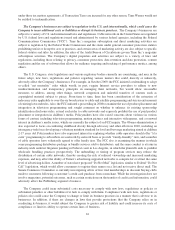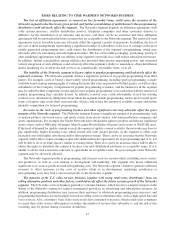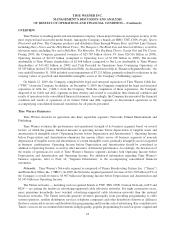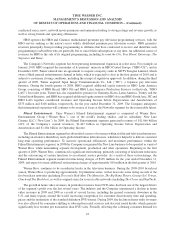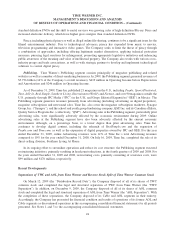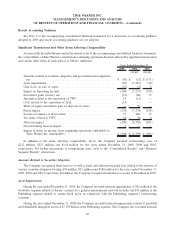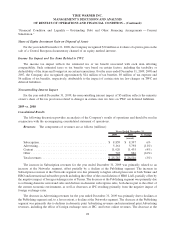Time Magazine 2009 Annual Report Download - page 30
Download and view the complete annual report
Please find page 30 of the 2009 Time Magazine annual report below. You can navigate through the pages in the report by either clicking on the pages listed below, or by using the keyword search tool below to find specific information within the annual report.RISKS RELATING TO TIME WARNER’S FILMED ENTERTAINMENT BUSINESS
A decrease in demand for television product could adversely affect Warner Bros.’ revenues. Warner Bros. is a
leading supplier of television programming. If there is a decrease in the demand for Warner Bros.’ television
product, it could lead to the launch of fewer new television series and a reduction in the number of original programs
ordered by the networks, the per-episode license fees generated by Warner Bros. in the near term and the
syndication revenues generated by Warner Bros. in the future. Various factors may increase the risk of such a
decrease in demand, including station group consolidation and vertical integration between station groups and
broadcast networks, as well as the vertical integration of television production studios and broadcast networks,
which can increase the networks’ reliance on their in-house or affiliated studios. In addition, the failure of ratings for
the programming to meet expectations and the shift of viewers and advertisers away from network television to
other entertainment and information outlets could adversely affect the amount and type (e.g., scripted drama) of
original programming ordered by networks and the amount they are willing to pay for such programming. Local
television stations may face loss of viewership and an accompanying loss of advertising revenues as viewers move
to other entertainment outlets, which may negatively affect the segment’s ability to obtain the per-episode license
fees in syndication that it has received in the past. Finally, the increasing popularity of local television content in
international markets also could result in decreased demand, fewer available broadcast slots, and lower licensing
and syndication revenues for U.S. television content.
If the costs of producing and marketing feature films increase in the future, it may be more difficult for a film
to generate a profit. The production and marketing of feature films require substantial capital. In recent years, the
costs of producing feature films have generally increased. If production and marketing costs increase in the future, it
may make it more difficult for the segment’s films to generate a profit. Such increases also create a greater need for
the Filmed Entertainment segment to generate revenues internationally or from other media, such as home
entertainment, television and new media.
Changes in estimates of future revenues from feature films could result in the write-off or the acceleration of
the amortization of film production costs. The Filmed Entertainment segment is required to amortize capitalized
film production costs over the expected revenue streams as it recognizes revenues from the associated films. The
amount of film production costs that will be amortized each quarter depends on how much future revenue the
segment expects to receive from each film. Unamortized film production costs are evaluated for impairment each
reporting period on a film-by-film basis. If estimated remaining revenue is not sufficient to recover the unamortized
film production costs plus expected but unincurred marketing costs, the unamortized film production costs will be
written down to fair value. In any given quarter, if the segment lowers its forecast with respect to total anticipated
revenue from any individual feature film, it would be required to accelerate amortization of related film costs. Such
a write-down or accelerated amortization could adversely affect the operating results of the Filmed Entertainment
segment.
18










